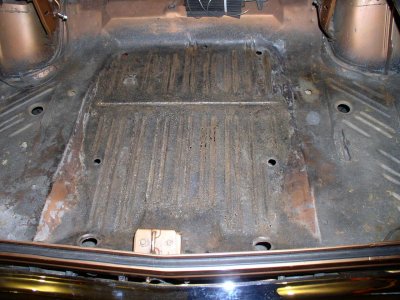Pretty common for the center to rot out i think.
This might not help you much but I once repaired the center of a 68 with a donor section from another 68.
Started with this
This is what i cut from the donor car, see how I got inside the frame rail runs and cut forward about to where the spare tire holder mounts?
On the car being repaired I made a very careful shallow cut on top of the inboard frame rail weld lips and pealed the bad skin out. Then i trimmed the donor pan to fit in like a puzzle piece. I was able to run a butt weld right on top of the inboard frame rail weld lip, it worked out pretty slick actually, blended out really nice. You couldn't tell it had been repaired when i was done.
I can't find any pictures of it after I finished and primed the trunk but it tirned out nice.
Here's another comment or experience I'll share that may or may not help.
I (in recent weeks) talked with Jeff at 521 about my trunk floor for my 69. I sounded just like you, was only interested in the center above the fuel tank.
Well I bought a 1 piece tank from Jeff and I was talking about just cutting out the center and i was willing to accept that amount of "waste".
When i really got into my tear down of my car i found that my trunk floor was weak in several areas outside of the center area over the tank.
back closer to the tail pan on both sides it was very weak, also between the frame rails and the trunk extension area it was weak.
I used almost the entire full pan in my car and I'm very glad i did it. i was able to clean the insides of my frame rails and rust proof them, I was able to inspect them and I found a crack inside each one where the shock crossmember is welded to the frame rails which I repaired. Yeah it was a little more work beings I decided to take it all the way to the factory tailpan welds. (you have to drill out the trunk latch box and the 2 tail pan braces) But wow i'm glad I did it, i gained access to my rear crossmember which needed some attention as well. It was a very good thing replacing my entire trunk floor, in my case it was anyways.
And I was sure I just needed the center section.
LH/RH halves is a good way to go too.

















